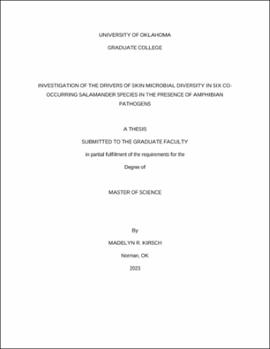| dc.description.abstract | Communities of symbiotic bacteria associated with a host, also known as microbiomes, have gained increased recognition for the myriad of key roles that they play. For example, microbiomes of the skin and gut have been linked to important host functions, such as immunity and digestion. The skin microbiome may be especially important in amphibians due to the extremely permeable nature of their skin through which they drink and respire. As a result, an imbalance in the composition of the skin microbiome, a condition known as “dysbiosis,” could have strong fitness consequences. Thus, identifying baseline skin microbial communities in amphibians may provide insight into their health and conservation needs, in addition to furthering our knowledge of microbial diversity. Several amphibian pathogens, including Batrachochytrium dendrobatidis (Bd) and viruses from the genus Ranavirus, currently decimate amphibian populations and are linked to significant changes in amphibian skin microbiomes. While an association between pathogen presence and amphibian skin microbial diversity has been demonstrated, it is not clear how widespread this pattern is or how it relates to other drivers of skin microbial diversity. For example, environmental, ecological, and genetic variables all impact the skin microbiome, making it important to quantify their contributions to microbiome structure in the presence of infection. To understand the joint influence of these factors, I used 16S sequencing to characterize the skin microbiomes of six salamander species found in Oklahoma and contrasted the effects of infection status, phylogeny, host ecology, and host environment on skin microbiomes. The results indicated that there was no phylogenetic influence on skin microbial diversity present; rather, unknown differences at the level of the salamander family were the main factors differentiating microbiome diversity, with host ecology and environment becoming more important at the level of differences among species. They also revealed a slight decrease in microbial diversity on animals that tested positive for Bd, whereas there were no microbiome differences associated with ranavirus presence. Together, these results indicate a nuanced relationship between the number and type of microbes present in the skin and the various factors influencing them. This work also provides a baseline for the skin microbiomes of six salamander species that had not been previously investigated. | en_US |
